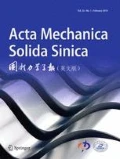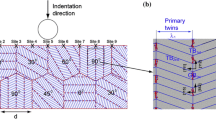Abstract
Multiscale simulations of the tilted flat-ended nanoindentation with different tilted angles (from 5° ~ 30°) on the (−110) surface of nickel crystal were studied using the QC method. The model of the indentation is a flat-end indenter inclined by an angle e driven into a half-plane vertically. Load-displacement responses, initial stages of the plasticity deformations and dislocation emissions for nickel film at different inclined angles were obtained and analyzed as well. An energy criterion was successfully proposed to analyze the critical load for the first dislocation emission beneath the edge of the indenter. Simulation results agree well with analytical ones. An elastic model based on the contact theory and the Peierls-Nabarro dislocation model were combined to analyze when and where the dislocation will be emitted beneath the lower surface of an inclined indenter. Results indicate that the key parameter is the ratio of the contact half-width to the position of the slip plane. This parameter shows the range in which a dislocation will probably be emitted. This mechanism explains the simulation results well. This work is of value for understanding the mechanism of dislocation emissions of FCC crystals under tilted flat-ended nanoindentation while providing approaches to predicting when the first dislocation will be emitted and where subsequent dislocations will probably be emitted.
Similar content being viewed by others
References
Poon, B., Rittel, D. and Ravichandran, G., An analysis of nanoindentation in linearly elastic solids. International Journal of Solids and Structures, 2008, 45(24): 6018–6033.
Oliver, W.C. and Pharr, G.M., Measurement of hardness and elastic modulus by instrumented indentation: advances in understanding and refinements to methodology. Journal of Materials Research, 2004, 19: 3–20.
Fischer-Cripps, A.C., Review of analysis and interpretation of nanoindentation test data. Surface & Coatings Technology, 2006, 200(14–15): 4153–4165.
Gouldstone, A., Van Vliet, K.J. and Suresh, S., Nanoindentation, simulation of defect nucleation in a crystal. Nature, 2001, 411(6838): 656.
Hu, E.L., Sun, Y., Zeng, F.L. and Qu, J.M., Nanoindentation simulation of PE/POSS under different shapes of indenters. Acta Mechanica Solida Sinica, 2011, 24(4): 365–372.
Tadmor, E.B., Ortiz, M. and Phillips, R., Nanoindentation and incipient plasticity. Journal of Materials Research, 1999, 14(6): 2234–2250.
Shenoy, V.B., Phillips, R. and Tadmor, E.B., Nucleation of dislocations beneath a plane strain indenter. Journal of the Mechanics and Physics of Solids, 2000, 48: 649–673.
Zeng, F.L. and Sun, Y., Quasicontinuum simulation of nanoindentation of nickel film. Acta Mechanica Solida Sinica, 2006, 19(4): 283–288.
Zeng, F.L., Sun, Y., Liu, Y.Z. and Zhou, Y., Multiscale simulations of wedged nanoindentation on nickel. Computational Materials Science, 2012, 62: 47–54.
Li, J.H., Zhao, X., Wang, S.Q. and Zhang, C.B., Multiscale simulation of the dislocation emissions of single Ni crystal in nanoindentation. Journal of Wuhan University of Technology-Materials Science Edition, 2010, 25: 423–428.
Feichtinger, D., Derlet, P.M. and Van Swygenhoven, H., Atomistic simulations of spherical indentations in nanocrystalline gold. Physical Review B, 2003, 67(2): 024113.
Pei, Q.X., Lu, C. and Lee, H.P., Large scale molecular dynamics study of nanometric machining of copper. Computational Materials Science, 2007, 41(2): 177–185.
Saraev, D. and Miller, R.E., Atomistic simulation of nanoindentation into copper multilayers. Modelling and Simulation in Materials Science and Engineering, 2005, 13(7): 1089–1099.
Hasebe, N., Kojima, K. and Qian, J., Incomplete frictional flat-ended punch on half-plane with edge crack. Journal of Engineering Mechanics, 1999, 125(3): 300–306.
Dupont, V. and Sansoz, F., Molecular dynamics study of crystal plasticity during nanoindentation in Ni nanowires. Journal of Materials Research, 2009, 24(3): 948–956.
Vadalakonda, S., Banerjee, R., Puthcode, A. and Mirshams, R., Comparison of incipient plasticity in bcc and fec metals studied using nanoindentation. Materials Science and Engineering A-Structural Materials Properties Microstructure and Processing, 2006, 426(1–2): 208–213.
Jin, J., Shevlin, S.A. and Guo, Z.X., Multiscale simulation of onset plasticity during nanoindentation of Al (001) surface. Acta Materialia, 2008, 56(16): 4358–4368.
Lu, H.B., Ni, Y.S., Mei, J.F., Li, J.W. and Wang, H.S., Anisotropic plastic deformation beneath surface step during nanoindentation of FCC Al by multiscale analysis. Computational Materials Science, 2012, 58: 192–200.
Tadmor, E.B., Ortiz, M. and Phillips, R., Quasicontinuum analysis of defects in solids. Philosophical Magazine, 1996, A73: 1529–1563.
Tadmor, E.B., Ortiz, M. and Phillips, R., Mixed atomistic and continuum models of deformation in solids. Langmuir, 1996, 12: 4529–4534.
Shenoy V.B., Miller, R., Tadmor, E.B., Phillips, R. and Ortiz, M., Quasicontinuum models of interfacial structure and deformation. Physical Review Letters, 1998, 80: 742–745.
Shenoy, V.B., Miller, R., Tadmor, E.B., Rodney, D., Phillips, R. and Ortiz, M., An adaptive finite flement approach to atomic-scale mechanics: the quasicontinuum method. Journal of the Mechanics and Physics of Solids, 1999, 47: 611–642.
Miller, R., Tadmor, E.B., Phillips, R. and Ortiz, M., Quasicontinuum simulation of fracture at the atomic scale. Modelling and Simulation in Materials Science and Engineering, 1998, 6: 607–638.
Miller, R. and Tadmor, E.B., A unified framework and performance benchmark of fourteen multiscale atomistic/continuum coupling methods. Modelling and Simulation in Materials Science and Engineering, 2009, 17: 053001.
Voter, A.F. and Chen, S.P., Accurate interatomic potentials for Ni, Al and Ni3 Al. Materials Research Society. Symposium Proceedings, 1987, 82: 175–180.
Sackfield, A., Truman, C.E. and Hills, D.A., The tilted punch under normal and shear load (with application to fretting tests). International Journal of Mechanical Sciences, 2001, 43(8): 1881–1892.
Muskhelishvili, N.I., Some Basic Problems of the Mathematical Theory of Elasticity. 3rd ed. P. Noordhoff Ltd., Groningen, the Netherlands, 1953.
Friedel, J., Dislocations. New York: Pergamon, 1964.
Rice, J.R., Dislocation nucleation from a crack tip: an analysis based on the Peierls concept. Journal of the Mechanics and Physics of Solids, 1992, 40 (2): 239–271.
Author information
Authors and Affiliations
Corresponding author
Additional information
Project supported by the Science and Technology Innovation Talents Special Fund of Harbin (No. 2012RFQXG001), the National Natural Science Foundation of China (No. 11102053) and the China Scholarship Council (CSC).
Rights and permissions
About this article
Cite this article
Zeng, F., Zhao, B. & Sun, Y. Multiscale Simulation of Incipient Plasticity and Dislocation Nucleation on Nickel Film During Tilted Flat-Ended Nanoindentation. Acta Mech. Solida Sin. 28, 484–496 (2015). https://doi.org/10.1016/S0894-9166(15)30044-6
Received:
Revised:
Published:
Issue Date:
DOI: https://doi.org/10.1016/S0894-9166(15)30044-6




